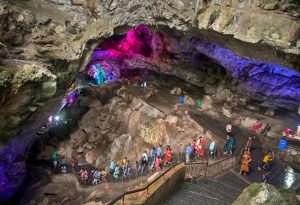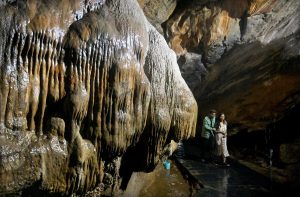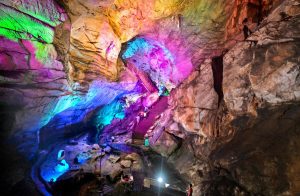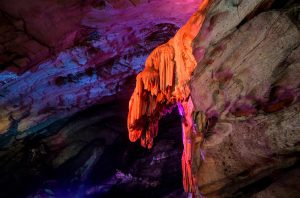05 Sep 2022 Borra Caves in Andhra Pradesh
GS Paper 1:Important Geophysical phenomena such as earthquakes, Tsunami, Volcanic activity, cyclone etc., geographical features and their location-changes in critical geographical features (including water-bodies and ice-caps) and in flora and fauna and the effects of such changes.

Image Courtesy: The Hindu
About Borra caves:
- Borra caves are ancient caves and among the deepest and longest caves in India. Geological Survey of India in 1807 discovered these caves.
- It is located in the Anantagiri hills of the Eastern Ghats range in Alluri Sitharama Raju district in Andhra Pradesh.
- Geological formation of Borra Caves is due to water activity from Gosthani river created Borra caves millions of years ago .
- Depth of karstic limestone structures in Borra caves extends up to 80 metres.
- Formation of stalagmites and stalacites happened in this cave due to the water activity cutting through rich limestone over the years.
- Anthropological research found unearthed stone tools of middle Paleolithic culture dating between 30,000 and 50,000 years ago confirming human habitation in that area.
- Caves are illuminated with artificial lighting to draw visitors from across India.

Image Courtesy: The Hindu
Mechanism for formation of Borra Caves:
- Creation of humic acid in the water due to partially decomposed organic matter .
- Gradual disintegration of stone due to reaction of acidic water with calcium carbonate in limestone leading to dissolution of minerals in the stone.
- Formation of Borra Caves happen when chemical reaction kept eroding the stones over a long period time due to small streams from the hillocks of the Gosthani River.
- Continuing chemical reaction, due to Gosthani river leading to formation of new shapes and changes in the shape of old ones.
- Stalagmites in the caves are formed when water percolates from the roof of the caves and reacts with calcium bicarbonate and other minerals on the rock forming mound-like structures on the ground .
- Stalactites are spear-like structures hanging from the roof .

Image Courtesy: The Hindu
What are the structures that inspire the viewer’s imagination?
- Many sculptures such as of mother-child, Shiva-Parvati, monkeys, brain, crocodile, rishi’s beard, cow’s udder are found in the caves.
- Naturally formed joint that links two huge stones from top to bottom are found at one end of the caves.
- Kottavasala-Kirandul railway line passes over the caves, deep inside at a point. The thickness of the rock at this point is 100 feet.
- Natural Shivling formed inside the caves, which is worshiped by inhabiting tribals.

Image Courtesy: The Hindu
Sources:-The Hindu; Times of India
Source Links:-
- The Hindu:-https://bit.ly/3QxsbDR
- Times of India:-https://bit.ly/3DbZOb6
Yojna IAS Daily current affairs eng med 5th Sep


No Comments